Assassin’s Creed is the latest huge crossover event under the Universes Beyond banner, celebrating 17 years of the legendary gaming franchise. Given the series’ broad roots in historical fiction, this set also has the fun side effect of introducing famous names like Leonardo Da Vinci, Socrates and Cleopatra to Magic!

No Pope or Doge cards though – guess we’ll have to wait for Universes Beyond: The Borgias there.
But it’s not only real-world history that makes Assassin’s Creed intriguing: it’s the connection to Magic’s design history, and the chance to revisit one of the game’s most storied creature types with new eyes.
AN ANCIENT TRADITION
Assassin’s Creed offers support cards and mechanics which will make all previous assassin-type creatures more viable, especially in a focused Commander deck. But assassins have always had a strong mechanical identity within Magic, going all the way back to the game’s earliest set.

Royal Assassin is one of the few Limited Edition Alpha cards to stand the test of time – while 1BB is a hefty investment for a 1/1, the ability to snipe any creature which taps to attack at no further cost remains a potent deterrent! Nekrataal soon advanced this art of murder to include ETB effects, and is still on par with the best effects in its class – perhaps ahead of them with the help of the new Assassin’s Creed cards.
Many subsequent assassins have been variants on one of these two designs for creature-based removal. Royal Assassin has never really been trumped for free repeatable activation – although Scarblade Elite might get there in an assassin-themed decklist!
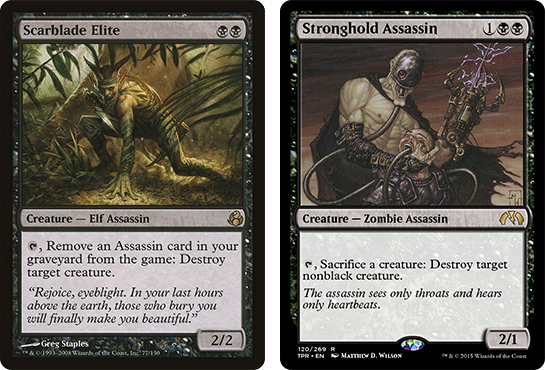
King’s Assassin, Stronghold Assassin, Mogg Assassin, Abyssal Hunter and Guul Draz Assassin round out the depth chart here. Assassins with high activation costs tend to lose a lot of utility, but Kiku, Night’s Flower deserves mention for being cheap to cast and a potential commander in her own right.
The pool of one-use assassins is much larger, perhaps because the Royal Assassin model proved too oppressive for the creature-friendly modern era. Big Game Hunter and Nightshade Assassin are very powerful for decks which can reliably discard them, since madness also doubles as a form of flash!

Callidus Assassin actually does have flash, albeit at a much, much higher casting cost. Garza’s Assassin and Silumgar Assassin are likewise able to activate at instant speed, though opposing removal might force you to pop them early.
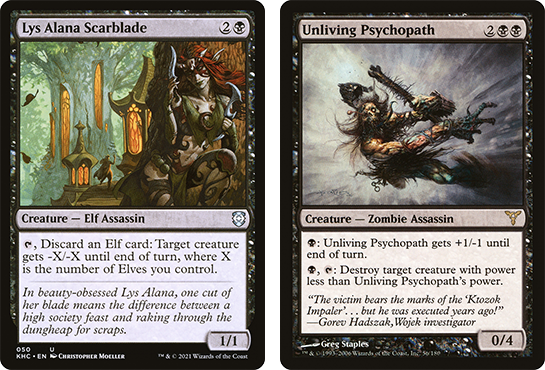
Lastly, there are some assassin cards that tie into specific non-assassin themes such as Lys Alana Scarblade in elves, Goblin Assassin in goblins, Silent Assassin and Rathi Assassin in mercenaries, Unliving Psychopath in zombies or equipment decks, or Hunter of Eyeblights and Massacre Girl, Known Killer in -1/-1 counter decks.
Your particular style of assassin deck might not find all of these cards to be equally useful. But the core idea of using creature cards as removal has only become stronger over time – and in decks which are built around the assassin type, there are ways to make murder even more rewarding.
KILLERS FOR HIRE
What sets assassins apart from ordinary killers is that they make murder a profession; selling their lethal skills to the highest bidder. One way for Magic to evoke this idea of a contract hit is using “bounty counters” to mark specific targets, coupled with a trigger which rewards you when these bounty-bearers die.
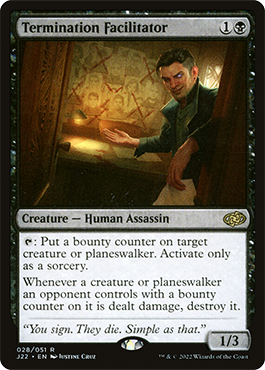
While stacking multiple bounty counters on a card has no benefit, you can stack up multiple payoff cards to claim all their rewards simultaneously! Even though most of these are (surprisingly) not assassins themselves, they synergise so well with the cards from the last section that I’d consider them essential support cards.
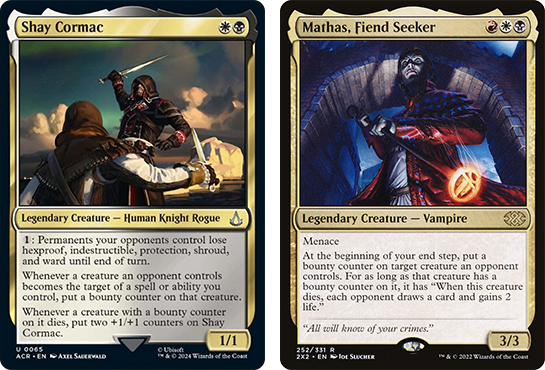
Bounty Hunter, Mathas, Fiend Seeker, Chevill, Bane of Monsters, and Termination Facilitator utilize bounty counters, along with Bounty Board and Shay Cormac from the new set. Xira, the Golden Sting, Massacre Girl, Known Killer and Kelsien, the Plague have slightly different methods of marking a target, while Vraska, the Silencer, Vein Ripper, and Twinblade Assassins are assassins which simply incentivize murder regardless of any prior mark!
A handful of other cards put an interesting twist on this idea using “hit counters”, which are placed on victims after they die rather than before. Etrata, the Silencer is most notable – a legendary assassin who offers both exiling removal and an alternate win condition. Making her your commander means you can return her to the command zone rather than shuffling her into your library.

Of course, a dedicated Etrata deck will usually have even better ways to cheat this downside: phasing or flickering her out of play before the shuffle, attacking with copies of the original or copying the trigger itself, or even destroying the target with some other assassin in response to fizzle the shuffle.
You can also shortcut Etrata’s win condition completely by using the other cards which place hit counters: Ravenloft Adventurer and Mari, the Killing Quill. Both of these place hit counters on anything that dies, so Etrata becomes very likely to one-shot whoever she attacks for the rest of the game!
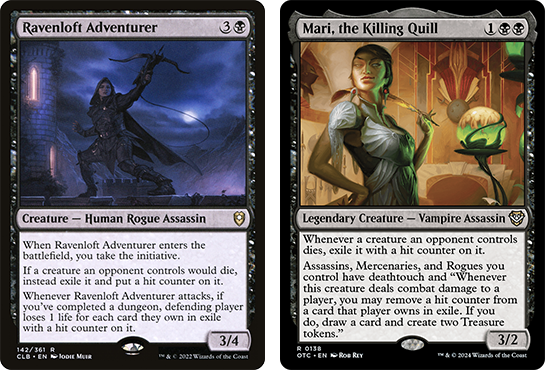
I really dig the flavor of bounty and hit counters, and while Assassin’s Creed indirectly makes these mechanics stronger I was disappointed that so few of the new cards actually interface with them. But perhaps that’s because the majority of the new set leans into a more recent interpretation of assassins in Magic: one where the hit is not carried out against a specific creature, but your opponents themselves.
NOTHING IS ABSOLUTE
Reframing the role of assassins as sniping players instead of creatures obviously leads to a significantly different kind of card design. The older assassin cards we’ve been discussing were defined by their usage outside of normal creature combat, in return sacrificing any real potential to attack or block.
But these new player-targeting assassin cards treat the combat phase like an infiltration mission. Their goal is to sneak past the guards (blockers) to land a clean blow on the opponent, generating some kind of additional value when they succeed. They usually have some form of evasion, or at least deathtouch to help discourage blocking. Over time, deathtouch itself has occasionally become a soft stand in for the assassin type, leading to designs like Vraska, Swarm’s Eminence.
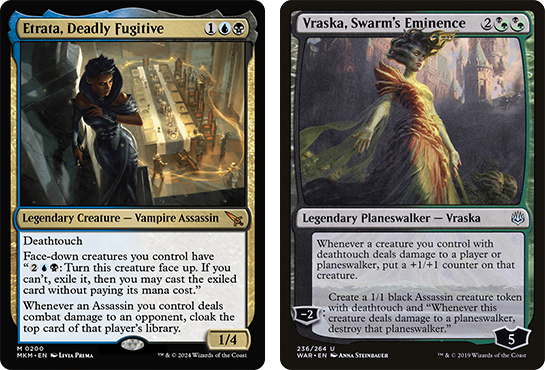
Beyond that, there is a huge variety of general support for dodging blockers across red, blue and black: it’s a mechanical theme shared by ninjas, pirates and rogues across all three colors, as well as the new pseudo-type of “outlaw” creatures defined in Outlaws of Thunder Junction. Rewards for this kind of “hit” can also be easily stacked up to make them more profitable, though some assassins still need to deal the damage themselves depending on how they’re worded.
Queen Marchesa, Virtus the Veiled, Ramses, Assassin Lord, Etrata, Deadly Fugitive, and OIivia, Opulent Outlaw are all good examples among our roster of pre-existing professionals. Looking to the new Assassin Creed cards we can add Basim Ibn Ishaq to that list, as well as Ratonhnhaké꞉ton, and Eivor, Wolf-Kissed. Ezio Auditore da Firenze (along with any freerunning cards), Ezio, Blade of Vengeance, Jacob Frye and Layla Hassan trigger no matter which of your assassins gets the job done.

Then there are cards like Aya of Alexandria, Kassandra, Eagle Bearer, Edward Kenway and Adéwalé, Breaker of Chains. These new assassins narrow the conditions for their damage triggers even further, but are still following the same design ideas and will synergize just fine with their comrades so long as those deckbuilding conditions are met.
EVERYTHING IS PERMITTED
I may not have spent much time with the Assassin’s Creed games, but as a fan of assassins in Magic I’m excited to see this creature type thrust towards the spotlight!
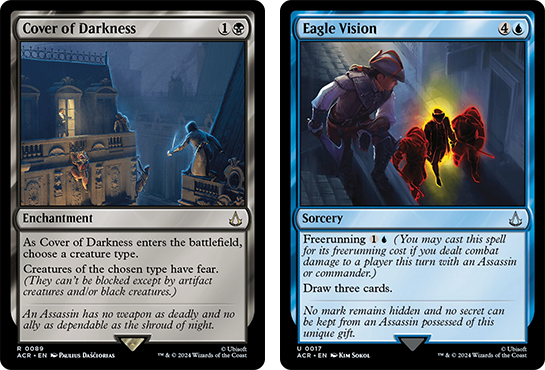
The coolest thing to me is how much flexibility players will now have when building assassin-themed Commander decks: one might choose to attack with an army of slippery unblockable killers, racking up different player-damage triggers. Another might chip away with just their commander and keep back a murderer’s row of Royal Assassin lookalikes to discourage retaliation.
And that’s not even considering the more fringe subthemes you could emphasize: historic-matters, deathtouch-matters, sacrifice and graveyard value, face-down creatures… these assassins are a flexible lot indeed!
Unfortunately, I don’t see quite enough raw power in Assassin’s Creed to surge the assassin archetype into Constructed relevance, although one or two of the cheaper creatures might find their way into Modern. But in Commander, it looks certain to elevate this interesting and storied creature type to breathtaking new heights.


Tom’s fate was sealed in 7th grade when his friend lent him a pile of commons to play Magic. He quickly picked up Boros and Orzhov decks in Ravnica block and has remained a staunch white magician ever since. A fan of all Constructed formats, he enjoys studying the history of the tournament meta. He specializes in midrange decks, especially Death & Taxes and Martyr Proc. One day, he swears he will win an MCQ with Evershrike. Ask him how at @AWanderingBard, or watch him stream Magic at twitch.tv/TheWanderingBard.

